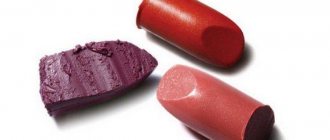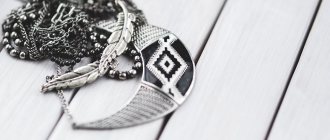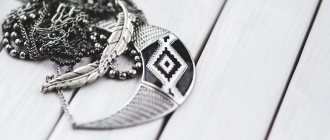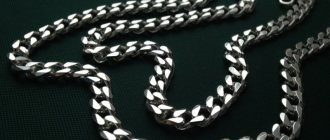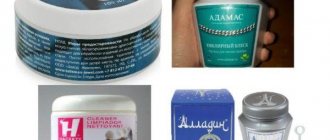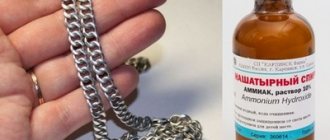Blackened silver is gaining popularity among buyers, since jewelry made from this type of precious metal has an unusual appearance that is distinguished by sophistication and looks like an antique.
Blackened silver ring
The following types of silver are used in jewelry:
- Sterling. This term refers to plain 925 sterling silver without additional plating. Therefore, sterling silver items require care and cleaning to remove tarnish. The test is popular in the manufacture of not only jewelry, but also cutlery.
- Blackened. Outwardly it looks like darkened silver, but the effect is achieved artificially. Does not require special cleaning.
- Oxidized. It looks like a blackened precious metal, but the effect of applying a dark layer is cheaper and short-lived.
- Rhodinated. Applying a layer of rhodium to a product without changing its color. This is done to protect the jewelry from scratches and darkening.
What is a mob?
Niello is one of the ancient techniques of decorating various silver and gold objects by painting them black. The consequence of using this technique is the contrast of colors on the surface of objects, and it does not matter whether it is an ornamental design or a relief detail.
Thus, silver blackening is also used to hide minor flaws on a product, such as small scratches or connecting seams. Blackened silver can easily be called a classic of the genre for making items in an antique style or with “traditional” notes. Blackening is a kind of “black” alloy of copper, silver, sulfur and lead fused into the base metal. The alloy is fused into a 0.3 mm depression, which is applied in several ways:
- minting;
- engraving;
- gouging;
- etching.
When heated, at high temperatures, a chemical reaction occurs between the melted mixture (black) and silver. Thus, in addition to new decorative properties, the blackened product also gains practical properties. Now it will not fade so quickly and will not require additional care. The color range of niello is quite wide: from light, silver-gray shades to noble velvet, black tones.
| Silver blackened pendants with amber insert | |
The niello alloy also looks very beautiful on high-grade gold and silver items. However, it is quite difficult to cast a high-quality niello composition that will not peel off gold, which is why niello coating on precious metals is used extremely rarely. From time immemorial, blackening of silver has been considered exquisite and the most durable. Well, if you really want gold jewelry, then you can, for example, gild the silver, protecting the areas with the finished niello with a special varnish. Why not?!
Benefits of silver products
Each of us chooses the decoration that we like and that you can afford. Gold is more expensive than silver. But this is not a minus, but a plus. In addition to price, silver has many advantages:
- We wrote about the price above. This is a profitable purchase;
- Silver goes very well with various stones;
- Silver products are suitable for various clothes;
- Silver is even used for medical purposes, as it has an antibacterial effect.
Since ancient times, silver has been endowed with magical qualities. It was believed that wearing such jewelry would help ward off evil spirits. Table sets are not only beautiful, but also healthy. Take care of your jewelry and products made from this noble metal, and they will serve you for many years.
Methods of applying niello
The niello is applied both wet and dry:
- In the dry method, the surface is wetted with the necessary special solution and finely ground black powder is applied. Then all this is carefully dried and fired in a muffle at a temperature of 300° to 400° C.
- In the wet application method, the composition is applied to the product in the form of a creamy porridge, which is diluted with water. Using a spatula or brush, spread the mixture tightly and thickly in the recesses and wait for the water to evaporate. Then, when heated in the muffle, the niello becomes soft, melts and flows into the design, covering the object. This means it's time to remove the product from the oven. Small decorations are melted with a soldering gun. The heat flow is concentrated on the base metal, so it is better to heat it from the reverse side. As soon as the mass melts, heating is completed.
| Silver blackened pendants with amber insert | |
Now it’s time to “clean up” the product with a scraper or file until a pattern appears. Very often, the background of the product requires additional engraving or shotting - applying strokes, dots or notches to the surface of the metal.
Having an understanding of the process of blackening products, you will be able to see flaws in jewelry on store shelves with the naked eye. For example, uneven background of the product: spots or bumps. You may notice splashes or streaks on light areas of the product. In general, negligence or, as experts say, a universal “vice”.
How does the process of blackening jewelry work?
Preparing decoration for blackening
Like any other process, it begins with a complete cleaning of the jewelry. It is washed, polished, ground; for products that have just come from the jeweler, all these steps are not needed. After all the manipulations done, the desired image is applied; this can happen in several ways:
- minting;
- etching;
- engraving;
- stamping.
The prepared blackening mixture is applied along the lines of the existing pattern (the depth of which must be at least 0.3 mm).
Applying the blackening mixture to the product
There are two types of mixture application method:
- Wet, in which a special prepared powder is moistened with water and carefully applied with a thin brush over the entire area of the image, carefully filling all the unevenness. After complete evaporation of the liquid, the product is placed in a special furnace (muffle), where the process of melting the working mixture occurs and it is evenly distributed over the entire surface of the pattern.
- The dry method is characterized by the separate application of components with different structures. First, a specially prepared liquid is applied. The next step is sprinkling with fine powder, which is done by thoroughly grinding the working mixture. Then the product is left to dry and only after that is sent to the oven.
Any chosen method ends with stripping. It is processed with a file or using the scraping technique. Here you need to be extremely careful so as not to catch the protrusions of the pattern.
Blackening silver at home
There are many simple home methods for blackening. It happens that you just urgently need to blacken a chain, ring, saucer or vase. As always, the Internet can help us. It is replete with all sorts of recipes: from boiled eggs, which are gentle on the product and do not harm the product, to pharmaceutical sulfur ointment and fixative for attaching photographs. If you choose sulfur ointment, you will need to thoroughly coat the surface with it, then dry it with a hot hairdryer until it drips. When the product turns dark purple, you need to rinse and dry the item.
To blacken silver at home, it is recommended to use iodine. In this case, you won't need a hairdryer. Simply coat the product with iodine, leave it to dry with iodine impregnation, and polish it thoroughly when dry. If you find it difficult to do this yourself, refer to the videos. Keep in mind that blackening is not that easy. Just the preparation of “sulfur liver,” as jewelers call it, is worth a lot. It is very harmful and smelly.
Modern blackening: liver of sulfur and sulfate film
Blackened silver is not at all the poor relative in the jewelry family. In price per gram, it is significantly more expensive than ordinary silver. But the only way to find that “classical” rabble, as in textbooks, among oxidized silver (numerous, but much less “resistant” relatives of rabble) is to threaten the seller with a silver bullet. It is the so-called “oxidation” that you will most likely encounter in jewelry stores - where the tags indicate “blackening”.
The technique of modern “lightweight” blackening is described in some detail here. Silver alloys themselves are already covered with sulfide and oxide films from interaction with the environment and your body - as a result they darken or otherwise lose their original white luster. That is why store salespeople usually advise customers to take “coated silver,” which is often a thin layer of noble (that is, environmentally resistant) metals—rhodium or ruthenium. Another popular (and fairly inexpensive) way to protect the shine of your products is coating with a thin sulfide film - the same as “oxidation”. In essence, it is an imitation of the natural processes characteristic of silver, but under strict technological control.
For this type of blackening of silver, production technologists prepare a special solution - most often “sulfur liver” from potassium carbonate (potash), sulfur and water (here - more about the composition of this substance). The composition of liver sulfur can be slightly varied to achieve different shades of film. The finished composition is simply applied with a brush to the prepared and cleaned surface of the metal, which must be heated, or, as an option, the product is dipped into it and wait a little while for the desired chemical reaction to occur. It is also possible to blacken using a galvanic method - by passing a current charge through a liquid (electrolyte) in a bath; this method is typical for mass production.
As a result, a durable protective film of the desired shade is formed on the product. The product is washed, areas where blackening is not required are polished (the film is washed), dried - and a finished blackened decoration is obtained.
Sulfate film is quite durable, protects and decorates the product, but there is a limit to everything. “The blackness has come off my ring” - this is precisely about this lightweight look, in contrast to the traditional blackness. In order for the decoration to retain its appearance longer, it needs at least minimal care. One of the gentlest ways to clean jewelry is to fill it with shampoo in a glass and forget about it for a couple of days (perfectionists can use “fairies”). And the good news is that your jewelry can easily be re-oxidized in a jewelry workshop.
Blackening silver at home
There are many simplified, even home-made methods (in case you need to blacken not a vase or dish, but a chain and ring). The Internet is filled with a variety of recipes, from boiled eggs (this method does not harm the inserts in the product) to sulfur pharmaceutical ointment (coat thoroughly, dry with a hot hairdryer until it flows, when it reaches a black-violet color, rinse and dry), or fixative for fixing photographs. It is advised to use iodine (then you don’t even need a hairdryer: coat it with iodine, leave it on the iodine impregnation and polish it after drying). There are also videos. A separate branch snakes around the forum of jewelers, whose texts are similar to the instructions of poisoners. By the way, preparing “sulfur liver” is extremely smelly and harmful.
Black on silver: styles and techniques
Blackened jewelry can be purchased in almost all jewelry stores. The main thing is to pay attention and check with the sellers whether this technique was used in the product you are trying on. After all, it may turn out to be a fake.
Israeli ethnic style jewelry deserves a separate topic. Israeli craftsmen use embossing, blackening and many other techniques in their works with their own stories. The decorations look like ancient ones, which we can only find in ancient human burials. In the cities of Ukraine and Russia today you can find many products from Israel.
Metal oxidation
Now you can find oxidized silver in stores, which is passed off as blackened. They may be visually similar, but they differ in quality.
Oxidized silver has the same blackish color, but with uneven filling and is slightly darker than real blackened silver should be.
Metal oxidation is a cheaper way to apply niello to a patterned surface. The product is coated with a thin oxide film, which creates blackness. The thicker the layer, the blacker the pattern will be.
But this method of blackening metal is short-lived. Over time, the film wears off and the item loses its original attractive appearance.
Original or fake?
Blackened silver, although at first glance some may not like it, turns out to be far from being the last relative in the jewelry business. The price of blackened metal may differ from the price of ordinary silver. You can't find niello in oxidized silver either. Oxidation, simply put, is an oxide film that protects the metal from tarnishing. It gives the product attractive properties. If for some reason the niello peels off the silver, it means it was oxidized.
By and large, you can get rid of blackening on jewelry. If you boil the product in a soda solution with foil, it will lighten. Housewives often practice this technique in everyday life, getting rid of any dirt, both on cutlery and on any other surfaces. A well-known gentle way to clean jewelry is to pour it in a glass with detergent or just shampoo and forget about it for a few days. If you don't believe me, don't waste your time and fill it with "Fairy".
Advantages and disadvantages
Disadvantages can be found in everything, but let's first look at the advantages of blackened silver.
- It may not be as carefully maintained as regular silver. On blackened silver, the dark coating will be completely invisible due to the contrast of colors and complexity of shapes.
- It retains its excellent appearance longer and is highly durable.
- Well, the third advantage is the bactericidal properties of the metal. We have already written about the benefits of silver before. Silver helps destroy pathogenic bacteria and microbes on the surface of the skin.
Blackened silver has no disadvantages, except for one thing - silver with blackened silver cannot be washed in boiled soda solution. To wash the product, you can use any other method of cleaning silver, or simply rinse in soapy water and dry thoroughly.
We wear jewelry made of blackened silver
Blackened silver with patterns is in great demand today and has many fans around the world. On sale you can find rings made of blackened silver, earrings, bracelets, pendants, made in different styles and manners. Quite often, these jewelry are complemented with precious and semi-precious stones: amber, garnet, pearls, diamond, emerald, ruby, etc. The cost of products with stones increases several times. As a rule, they are made of 925-grade metal, which means that they are very durable and do not require a lot of constant cleaning.
| Silver blackened earrings with amber inserts | |
Stylish silver jewelry with blackening is an ideal decoration for both special occasions and everyday wear. Blackened silver will suit any style of clothing, perhaps except sportswear and those that are overloaded with additional decorative elements. It will look great with an evening dress, a business suit and a light summer sundress. Blackened silver is not recommended to be worn to work or at home. Remove jewelry while cleaning and other household chores. Silver with stones requires careful treatment; it is worthy of the admiration of others.
When choosing blackened silver jewelry, pay attention to your skin color. If you have dark skin, try to choose light silver with dark patterns. If you have fair skin, it is better for you to wear silver-icy patterns on a dark background.
In completely different styles: “office”, “elven”, and “casual”, blackened jewelry will work “perfectly”. In addition, niello, unlike oxidized silver, is not at all afraid of chipping. But if the jewelry is too expensive for you, try to handle it very carefully if you want your favorite item to serve you for many years and please the eye at any moment.
Our online store “Yantar Polesie” will help you choose and buy earrings made of blackened silver or other silver jewelry!
Varieties of silver
Pure silver has a white color with a silvery tint. But pure silver is too malleable; it cannot be used to make filigree jewelry or a sophisticated box. Therefore, alloys of various metals are added to silver, and depending on the percentage of silver and alloy, the color of the product and its characteristics change. So, today there are several types of silver:
- Matte. They are obtained in different ways: by etching a special emulsion, using a sandblasting machine or a vibroengraver. The product is obtained with a fine-grained rough surface without gloss. Matte silver items look very elegant and unusual. Often such items are chosen as an exclusive decorative gift.
- Coin. Surprisingly, coins were not made from this type of silver, as it might mistakenly seem. Coin silver contains a large percentage of silver (90%) and only 10% copper (rarely nickel or zinc). This alloy composition provides strength and wear resistance to the products. And the name most likely came from ancient times, when people brought silver coins to the master to be melted down. Nowadays coin silver is 900 silver.
- Filigree. This is silver of the highest 960 standard, that is, it consists of 96% silver and 4% alloys of other metals. A thin silver thread is forged from this type of silver and then we form openwork patterns and complex ornaments. Making jewelry from filigree silver is considered a very difficult task, which only true masters can do.
- Blackened. That same silver with the contrast of white and black. Jewelry made from niello looks authentic and sophisticated, and serving items add luxury to any interior. Blackened silver is produced by applying black to pure metal. Next we will look in detail at the methods of blackening silver.
Get rid of blackheads in 30 minutes
The most affordable and easiest way to get rid of black metal: clean the precious metal with a soda solution.
You need to pour 2-3 teaspoons of baking soda into a saucepan with water. Place foil on the bottom of the container and decorations on top. Boil the contents of the saucepan for about 5 minutes. By the way, this cleaning method is also applicable for tableware and silverware.
Another effective means for cleaning silver items from niello is citric acid. Moreover, you can use both powdered citric acid and juice squeezed from lemon.
Lemon juice, which is not as concentrated as citric acid, is more gentle on the blackness on silver.
How to clean silver from blackness using citric acid? Dissolve 100 g of powder in half a liter of water in a bowl, wrap silver items in foil, and place inside the container. Boil the solution for 15 minutes. Boiling in a lemon solution helps make the product snow-white and shining.
Mechanical method
How to darken silver at home with graphite? This is a fairly simple technology, and its result is due to the same processes that occur with lunar metal over time. That is, dust particles stick to it and firmly “eat” into the recesses. Using graphite you can simply speed up this process.
To blacken the product, they are lubricated with a mixture of graphite powder, iron oxide and turpentine, diluted to a pasty state. Then wait for it to dry completely and wipe the silver with a soft cloth. The older the product, and the more uneven its surface, the more noticeable the result will be. But in general, such blackening is less durable than that obtained by chemical or galvanic methods.
Blackening of metals - a classic method
Jewelry craftsmanship in Russia reached its peak more than a thousand years ago; our ancestors created such famous techniques as niello, filigree , granulation; metal processing methods have survived to this day and are widely used in crafts.
Filigree is a decoration made using twisted strips of metal that are stretched and twisted.
Granulation is a method of decorating the surface of a product with small balls of metal (the granulation technique could not be recreated for a long time; most of the technology was lost).
How blackening of metals occurs in stages.
- The master prepares a mixture for the mob.
- Grinds the surface to be processed, applies a pattern to the surface (cuts grooves in the metal with a depth of 0t 0.3 to 3 mm.
- Pour the prepared mixture into the grooves.
- Places the product in the kiln for firing.
- Polishes jewelry, removes excess layer of blackened composition from the surface of the product.
Depending on the type of decoration and the artist’s idea, after polishing, you can gild the product, decorate it with filigree, precious stones, etc.
Jewelry craftsmanship in Rus'
The ancient Russians were well versed in the craft of creating beautiful and bright jewelry. To do this, they had several basic techniques for creating ornaments on jewelry:
- filigree - applied using thin strips of precious metal;
- niello - a method of blackening silver or gold;
- grain - jewelry was decorated with small balls of gold or silver.
Historical information
Silver blackening at home began for the first time in the 17th century in the Russian Empire. During this era, craftsmen appeared in the city of Veliky Ustyug who began to make the metal darker. Trade routes from Siberia and other countries passed through this area for a very long time. In almost every courtyard, craftsmen appeared who developed their own techniques for creating jewelry from blackened silver.
All stages from embossing the product to its darkening were carried out manually. Due to the fact that the masters refused to tell the secrets of the procedure to anyone except their family, the craft almost disappeared completely. Then they began to apply the technology on a large scale. In addition to cutlery, furniture and jewelry, they even made silver paintings - portraits, landscapes, still lifes. Even today you can find antique products by Russian craftsmen in specialized and antique stores.
There are several types of metal processing styles:
- Velikiy Ustyug;
- Dagestan;
- Israeli.
Jewelry made in Veliky Ustyug is distinguished by soft designs, floral and naturalistic motifs, and geometric patterns. Dagestan jewelers work with the help of a chisel; they create drawings of strict forms, deep clear engraving, and use shotting together with blackening. The Israelis try to create products in such a form as if they had recently been found by archaeologists during excavations. Their works are distinguished by embossing, which ages them.
Self-blackening
Blackening silver at home is not difficult. Moreover, this can be easily done using available tools, and your decoration will take on a new look.
1) So, for the first method you will need:
- a container that is hermetically sealed;
- egg;
- thread.
The egg should be hard boiled. Next, peel it and cut it into two parts. Place the halves in a container, and hang a silver item from the lid of the container. Blackening will be formed due to the action of hydrogen sulfide on the jewelry, but the blackening of silver may be uneven, so it is recommended to change the position of the jewelry from time to time. If there are stones on the jewelry, wipe them while blackening. The method itself is harmless, but the inlay may darken slightly if it is not wiped.
2) For the next method you need to purchase sulfur ointment. Then apply it to the product or those fragments that should later turn black. Apply a hairdryer with warm air to the jewelry and you will see how it changes color, becoming black. After the procedure, polish the product.
3) You can also apply blackness using iodine. This technique is only suitable for jewelry with relief. Iodine is applied with a cotton swab and dried in the sun. It is best to polish finished blackened silver using a brush and toothpaste.
Only gentle methods are suitable for cleaning blackened silver. Do not use acids or boil the product. If you want to clean your jewelry, simply prepare a soapy solution and add a pinch of baking soda to it. The water should be warm and the decoration should lie there for about 20 minutes. It is forbidden to rub blackened silver with soda or tooth powder; it can damage the blackening.
Products made from blackened silver are more solemn than ordinary ones. Therefore, it is appropriate to wear them at receptions or holidays. For everyday use, it is better to choose sterling silver options. And carefully monitor and care for blackened products.
Basic technique
Blackening of silver refers to decorative finishing. A special alloy consisting of sulphides of sulfur, lead and copper is applied to the metal. As a result of the procedure, the decoration acquires a deeper and clearer relief, and cutouts, recesses and figures receive a black tint.
The product is heated to a certain temperature, due to which the alloy is firmly bonded to its surface. The decoration becomes more contrasting and patterned, taking on the appearance of an antique. Its price depends on the degree of skill of the jeweler, the complexity of the work and the size of the product.
The blackening of the metal is reminiscent of the champlevé enamel technique. There are three types of creating a blackening mixture:
- German;
- Russian pre-revolutionary;
- modern.
In the first option, the master pours lead into the silver-copper alloy and mixes the solution well. Then the mixture is poured into sulfur powder and stirred until smooth. After this, the mass is poured into cold water. I transfer the frozen pieces into a porcelain mortar and grind them into powder with a pestle. The wet mass can be applied to the product.
According to the old Russian recipe, the solution is not poured into powder, but sulfur is added to the mixture and kneaded. Then the mass is transferred to a cast iron frying pan, forming one solid piece, shaped like a pancake. The lump is crushed into small pieces and melted again, adding flux and sulfur. To achieve high-quality niello, the procedure is repeated three times. After this, it is crushed, sifted and the product is decorated.
The third method was created at the Moscow Institute of Non-Ferrous Metals by one of the professors. Copper sulfide and silver, lead are prepared separately and mixed in certain proportions. Then the mixture is melted, cooled and crushed, and the surface of the jewelry is covered with the finished mass.
Product care
Although items made of blackened silver do not tarnish, dirt may well accumulate on them. Therefore, it is recommended to care for it regularly, wash, wipe and dry well.
- A regular soap solution is perfect for removing light dirt and dust from the recesses of the product.
- You can use potato infusion for cleaning. Pour water over the peeled potatoes and let it brew. Then place the blackened silver there and leave it for several hours (up to 4). Afterwards, as always, rinse and wipe.
- Never use harsh or abrasive products, such as ammonia, dry baking soda powder, etc., to clean blackened silver.
- Plus, blackened silver does not tolerate hot temperatures, which means that all methods involving boiling will not work.
- Such items can only be wiped with a soft cloth and stored in a dry, dark place.
Reviews
I purchased women's stud earrings made of blackened metal. The earrings have a simple flower shape, but they attract the eye thanks to the “antique” material. Previously, I was skeptical about blackening, I thought that it was an analogue of gilding. Now I’m thinking of completely switching to black silver products.
Maria L., Kostroma
Svetlana K., Moscow
I order silver jewelry through Avito from private craftsmen. The product is always high quality and exclusive. The last time I ordered a man's amulet for the neck. I was very pleased, amazing work, decent quality of material.
I never thought that fine jewelry could be called “rabble.” I purchased several rings made of blackened precious metal to complement my daily look. Even my husband didn’t stand aside; he bought himself a gray and black chain; it looks much more brutal than classic chains.
Zhanna R. g, Stavropol
Emergence of mastery
The history of the development of blackening began in the 5th century BC. e. It was most developed among the tribes of the Black Sea region who lived in the north. The blackening technique became most popular in the 10th century AD. e., namely in the city of Chernigov. Afterwards, blackening as a skill spread far beyond the Russian lands.
Craftsmen of Veliky Ustyug in the 18th century created an entire school to teach the skill of blackening metal. They are considered the founders of modern technology. Blackening is used in jewelry to this day.



